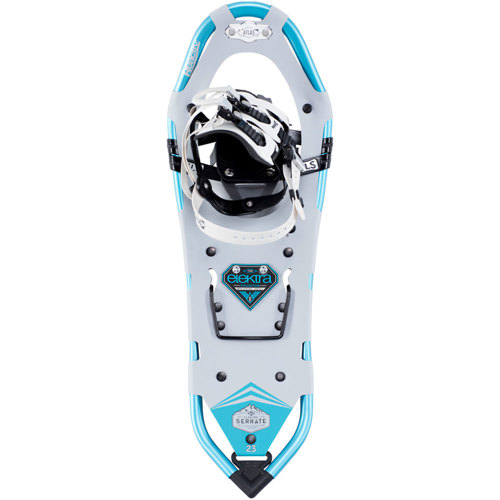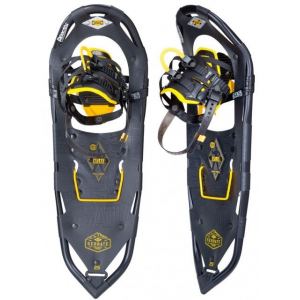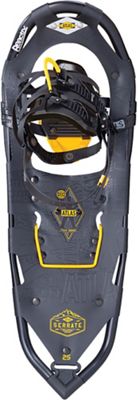
Atlas' Serrate Snowshoes are teardrop-shaped, nylon-decked snowshoes with crampons and a heel lift designed for hiking and snowshoeing in mountainous terrain. They have a simple-to-use binding system that's compatible with virtually any kind of winter boot or shoe, but runs a little on the bulky side when strapped to a backpack. That's often the tradeoff with a user-friendly binding system and the Serrates aren't unusual in that regard.

Specs at a glance
- Sizes and max recommended loads:
- 25 in (200 lbs)
- 30 in (250 lbs)
- 35 in (300 lbs)
- Gender: men's, a women's model is also available called the Electra Serrate
- Frame material: Aluminum
- Decking: Nylon
- Heel Bar: Yes
- Crampons: Stainless steel
- Heel, toe, and side traction
- Weight/pair
- 25 in: 4 lbs (4 lbs 2 oz – actual, tested)
- 30 in: 4 lbs 8 oz
- 35 IN: 4 lbs 8.6 oz
Bindings
The Serrate snowshoes have a step-in binding that wraps around your forefoot and is closed when you pull on a single top strap, shaped like a handle. There's a second rear strap that wraps around your heel and tightens with a buckle. The bindings are foot specific. It's pretty easy to figure out which is which, but they're also labelled with "RIGHT" and "LEFT". That's it. They're fast to put on and provide a secure grip, without a lot of uncomfortable foot pressure. To release your boots, you simply pull on grey loop (below).

To tighten, you pull on the black loop (below). The binding grips the sides of your boot and provides gentle top down pressure to keep your foot locked in pace, without any slippage. When you put your foot into the binding, you will want to keep a 1-2 inch gap between the nylon decking and the front of your foot, so your boot doesn't catch on it when you walk forward

The rear binding strap uses the same identical toothed buckle that's used on the Tubb Flex VRT snowshoes, which isn't surprising because Tubbs and Atlas are owned by the same parent company, K2 International. The rear strap is non-intuitive, but works well if you simply pull on the end of the strap to lock it in place. I would have preferred a ratchet-style buckle, but they probably vetoed it on the basis of increased material cost.
Crampons
The Serrates have an aggressive set of crampons under the binding (forefoot) and the heel. There's also a right and left run of stainless steel teeth along the sides of the heel crampon to prevent slipping when you have to sidehill across a slope. Both the front and rear crampons have teeth that point forward and backward, the latter to prevent slipping backwards down a slope. They're designed for use in icy and slippery mountainous terrain and perform wonderfully in sketchy conditions.

The front crampon is hinged, so it rotates each time you take a step forward. There's a stiff plastic strap that runs under the front crampon, what Altas refers to as a "spring loaded suspension", which keeps the front teeth angled slightly forward, so you get optimal crampon purchase every time you take a step. It also lets the front crampon "float" laterally and rotate a bit if you hit uneven terrain or rocks, although the effect is pretty muted.
This type of crampon system is optimized for use with a tear-drop shaped, decked snowshoe, but very different from the crampon traction you find on snowshoes that are rectangular or have a frame that is toothed and acts as a crampon itself, like the MSR Lightning Ascent. Snowshoeing in the Serrates in more like natural walking when snowshoeing in powder or on top of crusty snow, and less like trying to walk with rectangular boards strapped to your feet .
Heel Bar
The Serrate snowshoes have a flip-up heel bar under the heel that can be used when walking up inclines. It's designed to reduce calf fatigue, by reducing the amount of stretch required by your calf muscles. It's best used when you're walking up a steep slope and not just a gentle incline. When raised, it also lets your heel exert direct pressure on the rear crampons, which provides significant traction when climbing icy slopes. When you reach a flat area, you can easily whack your trekking pole handles at the heel bar and it will drop back down again.

The heel bar assembly is connected to the side traction bars that run along the sides of the heel crampon. It's also one of the most robust constructions I've seen on a mountaineering snowshoe and unlikely to pop out or sheer, since the side rails are made with stainless steel.
Flotation
The Serrate snowshoes provides excellent flotation in powdery conditions due to the snowshoe's wide front and tapered body and tail. This shape, called a "modified bearpaw" in classical terms, is versatile across a wide range of snow conditions, both on trail and off. The big rounded and slightly upturned toe helps floats the snowshoe high in soft powder while the long and rounded tail provides a counter balance and makes it easier to back up or maneuver in vegetation.
Recommendation
The Atlas Serrate Snowshoes are rugged snowshoes designed for traveling in mountainous terrain. Their teardrop shape and upturned toe provides excellent flotation in powdery snow, while their aggressive forefoot, heel, and side crampons provide superior traction over ice, frozen snow, and slab. While the Serrates are aggressive snowshoes, their best feature is the easy-to-use binding system. While somewhat bulky, it intuitive to use and stays on securely. If you want a high flotation snowshoe for mountainous terrain, the Atlas Serrates are an excellent choice.
Compare 5 Prices
-

 Amazon US
Amazon US $289.95$199.99View -
 Moosejaw
Moosejaw $289.95$231.99View -
 Moosejaw
Moosejaw $289.95$245.99View -

 Sunny Sports $289.95View
Sunny Sports $289.95View -

 REI.com $289.95View
REI.com $289.95View -

 CampSaver.com $289.95View
CampSaver.com $289.95View
Disclosure: Atlas provided the author with sample snowshoes for this review.
Editor's note: Help support this site by making your next gear purchase through one of the links above. Click a link, buy what you need, and the seller will contribute a portion of the purchase price to support SectionHiker's unsponsored gear reviews, articles, and hiking guides.The post Atlas Serrate Snowshoes Review appeared first on Section Hikers Backpacking Blog.
from Section Hikers Backpacking Blog http://bit.ly/2QagmUN


No comments:
Post a Comment